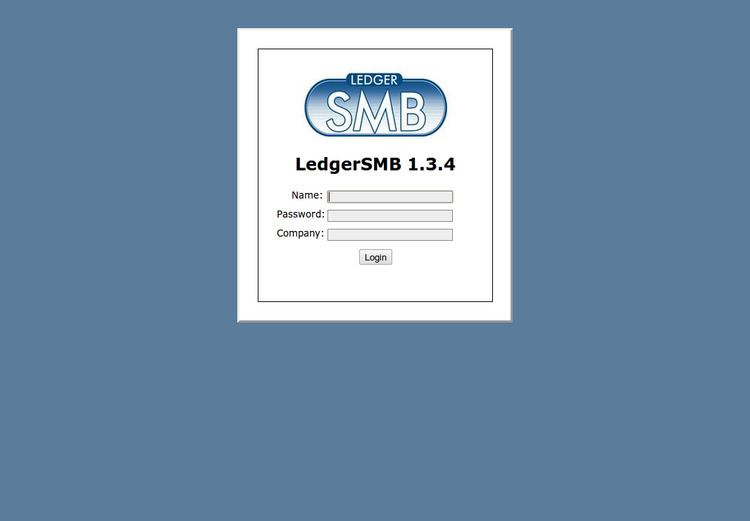Initial release 2006-09-06 Development status Active Platform Cross-platform | Stable release 1.5.5 / 2017-03-14 | |
 | ||
Operating system | ||
LedgerSMB is a free software double entry accounting and Enterprise resource planning (ERP) system. Accounting data is stored in a SQL database server and a standard web browser can be used as its user interface. The system uses the Perl programming language and a Perl database interface module for processing, and PostgreSQL for data storage. LedgerSMB has Multitenancy support.
Contents
LedgerSMB is distributed under the terms of the GNU General Public License v2.
Features
LedgerSMB features
LedgerSMB supports multiple currencies, multiple sales or VAT tax rates and per-user language and locale (number formatting) settings. It also supports per-customer language settings, so invoices can be translated into various languages when printed, and per-language invoice templates are also an option.
Releases
1.5.0 was released on 2016-12-24 with a change log focussed on stability and user experience.
1.4.0 was released on 2014-09-15 with another sizeable change log.
The 1.3.0 release came out on 2011-10-11, with a sizeable change log, generally focussing on performance, separation of duties and fixing the (design) issues in 1.2.
The 1.2.0 release (announced on 2007-04-06) included a number of very deep security fixes and the beginnings of the refactoring process. The tax and price matrix code was centralized. This release was quite problematic and the core team ended up pulling 1.2.0 and 1.2.1 from public distribution due to a number of issues in integrating old and new code. Many members of the core team have expressed frustration at the level of problems, but Chris Travers has generally compared the problems to those of Apache 2.0, where changes in architecture have caused problematic releases. The general hope is that 1.2.x will be the most difficult and problematic release, perhaps of all time. At the same time, it cannot be denied that a number of the problems in 1.2.0 were the result of trying to do too much too quickly without adequate review. It is difficult to fault the project for this in some cases (removing SQL injection issues) but it remains to be seen whether the project is able to continue to move forward in such a way as to prevent this from being a problem in the future.
The 1.1.0 release merged in many patches that had been done for other customers but did not change the structure of the code in any significant way. By this time, however, most of the core members were unhappy with the current architecture and had decided to work on refactoring the code.
The initial release (1.0.0 on 2006-09-06) and the events leading up to it, are described in the History section.
1.5+ Developments
As of 1.5, development has taken a direction to move to a heavier (in-browser) client with access to web services in the backend. To that extent, the 1.5 UI has been realised as a single-page web application. The result is a (much) more responsive experience which looks a lot more modern and builds a foundation for much more fundamental separation of front and back end. Massive efforts have gone into developing quality assurance measures during the development 1.5 cycle and continue to be a focus going forward.
1.3+ Developments
Prior to 1.3, there were numerous challenges in the code base, such as the fact that the Perl code generated both database queries and web pages by using a combination of string-concatenation and string-printing page snippets to compose the resulting HTML. While this functioned reasonably well, it made the interface very difficult to modify, and interoperability with projects written in other languages particularly difficult. Additionally, most state was kept in global variables which were modified all over the place, leading to unexpected results on nearly every code-modification.
Faced with these challenges, the LedgerSMB team developed a new architecture which addresses these issues by adding support for templates in the user interface, and moving all database calls into stored procedures. Although closely resembling model-view-controller (MVC) in structure, it is not broken down in precisely the same way as other MVC implementations.
The overall design considerations included a desire to ensure that multiple programming languages could be used cross-platform to access LedgerSMB logic and that security would be consistently enforced across these applications. Thus the LedgerSMB team envisioned a "one database, many applications" environment typical of PostgreSQL. The overall approach heavily leverages PostgreSQL roles (application users are database users, and are assigned roles). Access to the database logic for new code (added in 1.3 or later) goes through stored procedures which act like named queries. Permissions are sometimes granted on underlying relations or on the stored procedures. The stored procedures have semantic argument names, allowing for automatic mapping in of object properties. These are then exposed to the Perl code through fairly light-weight wrappers. User interface code wrapped around Template Toolkit, which is also used for generating PDF's via LaTeX, CSV files, Excel, Open Document etc. Workflow is handled through relatively light-weight Perl scripting.
History
The project began as a fork of SQL-Ledger when Chris Travers, dissatisfied with the handling of security bugs in SQL-Ledger, partnered with Christopher Murtagh to produce a fix for CVE-2006-4244. This bug was apparently reported to the SQL-Ledger author, Dieter Simader, several months prior to the Chris' working on a patch. The initial release of LedgerSMB, along with full disclosure of the bug on the main mailing list, strained relations between SQL-Ledger supporters and the members of the nascent LedgerSMB project.
The forking of LedgerSMB is considered by some to be part of the reason for the anti-forking clause in the short-lived SQL-Ledger Open Source License, which was used for SQL-Ledger 2.8.0.
